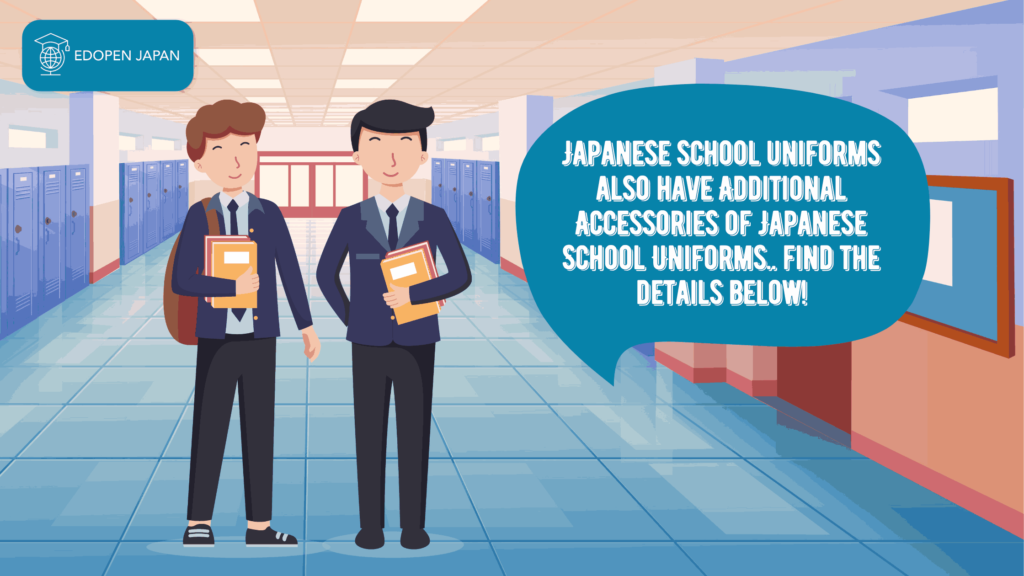When watching Anime or J-Drama, one may become interested in the Japanese school uniforms worn by the actors. It is undeniablethat Japanese school uniforms are attractive and elegant. Although school uniforms are typically considered standard and unobtrusive, this is not the case in Japan.
This article will focus on Japanese school uniforms. According to history, Japanese school uniforms originated from the adoption of a Navy-style uniform by an educational institution of the imperial family and nobles during the Meiji period. Please see below for the detail information.
In addition, if you want to learn more about other Japanese culture which is also very interesting, please also read our reading recommendations below just for you!
Read also:
10 Most Popular International Universities in Tokyo
High School in Japan: Everything You Need to Know
10 Most Popular & Prestigious Medical Schools in Japan
Contents
The History of Japanese School Uniforms

In Japan, students initially wore standard clothing to school, with male students wearing hakama and female students wearing kimono. However, during the Meiji period, school uniforms in Japan began to evolve. The earliest Japanese uniforms were created by Gakushūin, an academic institution for the imperial family and nobility, which was founded in the 1890s at the beginning of the Meiji Era (1868-1912).
During that period, Gakushūin introduced a uniform for male students modeled after the formal attire of Japanese naval officers. The uniform, known as Gakuran, consisted of a high-collared jacket, trousers, and a hat. Initially, only the elite Gakushūin students could afford such uniforms. This is the origin of the male student uniform.
The history of female student uniforms in Japan can be traced back to the reforms implemented by Utako Shimoda (1854-1936), a women’s activist, educator, and fashion designer. Shimoda recognized that the traditional kimono hindered girls’ physical activity and put their safety at risk.
In the early 1920s, female student uniforms underwent a transformation, adopting navy uniforms combined with European styles, now known as Sailor Suits or Sailor Fukus. These uniforms were easy to sew, facilitated movement, and supported the physical activities of female students.
The Variations of Japanese School Uniforms
In Japan, schools generally have two different uniform styles: traditional or modern. The typical uniform colors are navy, green, black, and white.
The variations of school uniforms in Japan have garnered attention, due to their different rules and cultural significance.Some schools have a particular uniform style to showcase their unique character, philosophy, and specific rules.
In Japan, school uniforms often hold sentimental value for students as they represent specific moments in their youth. However, it is important to maintain the uniform’s intended design and not make modifications such as changing the length of the skirt or detaching the ribbon.
The Regulations of Japanese School Uniform

In Japan, elementary school students are not required to wear uniforms to school, although regulations vary among schools. However, most public and private junior and senior high schools in Japan have uniform requirements.
Additionally, most schools have both summer and winter uniforms. The summer uniforms are typically lighter and simpler, while the winter uniforms are more formal and made of heavier materials, often including blazer jackets to keep students warm.
Gakuran: Boy’s Uniform
The Gakuran, a Japanese school uniform for boys, was adopted from the Prussian army uniform known as Waffenrock. The term Gakuran is a combination of ‘Gaku’ (学), meaning ‘study’ or ‘student’, and ‘Ran’ (らん or 蘭), meaning the Netherlands, which is generally assumed to refer to the West in Japan. Therefore, Gakuran commonly translates to ‘Western-style uniforms’.
Gakuran typically consists of several items as the following:
1. Sturdy-shouldered top with stand-up collar
2. White-collared shirt
3. five charming golden or bronze buttons
4. straight black pants
5. The color is black or blue-navy
6. Brown or black leather shoes or loafers
Sailor Fuku: Girl’s Uniform
The uniform worn by female Japanese middle and high school students, commonly known as sailor suits, is considered attractive. The uniform was designed by Utako Shimoda in the 1920s with the intention of supporting girls’ movements. It is a simple design that is easy to sew. The sailor suits typically include the following items:
1. White shirt with a sailor-style collar
2. Kerchief, bow, or tie
3. Skirt with pleats
4. White, navy, or black socks
5. Brown or black shoes
During the colder seasons, girls often add a sweater to their outfits for added warmth.
2 Types of Japanese Uniforms in Winter and Summer

Japanese middle and high school uniforms are designed to reflect the changing seasons, with two sets of uniforms for summer and winter, as well as sportswear. The details for each item are as follows:
- Uniform for Summer: white and short shirt, light trousers for boys or a pleated skirt for girls with t-shirt and shorts for sports.
- Uniform for Winter: sweater, blazer, long trousers or skirts, polyester tracksuits for sports
The Modern-Styled Japanese Uniforms
Recently, there has been a noticeable shift in the design of Japanese school uniforms. Some schools have even adopted a western-style pattern. The typical uniform includes:
- A white shirt, tie with certain motif and a distinctive blazer with the school crest
- Trousers specifically designed for boys and a plaid skirt with high and loose socks for girls.
In contrast, it is argued that the most recent development in Japanese school uniforms is the freedom to not wear a uniform at all. Several junior high and high schools in Japan have also adopted this rule, loosening their uniform policies.
Japanese school uniforms continue to receive international attention due to their frequent appearances in various media such as anime, J-Drama, and social media, which representyoung Japanese. This aspect cannot be neglected as it is a significant attraction for foreign tourists visiting Japan.
The Japanese School Uniform’s Regulation
As is well-known, cleanliness and appearance are highly valued in Japan. School uniforms are taken very seriously, with strict rules that students must follow. These rules often regulate not only the color of clothing, socks, and shoes, but also the length of skirts for girls and the length and shape of trousers for boys.
Any mention of the haircut should be avoided as it is not relevant to the topic. The uniform must be worn properly and neatly not only within the school environment but also outside of it.
The Real Japanese School Uniforms Vs Anime

If you have ever wondered whether the school uniforms in anime are the same as those in Japanese schools, the answer is no. In reality, Japanese student uniforms are typically plainer than those depicted in anime.
For example, anime often portrays female students wearing very tight uniforms with pastel pink miniskirts, which is highly unlikely in real Japanese schools.
The length of the skirt will increase when opting for a more conservative color, such as dark blue or beige. The designs and styles of uniforms are more restricted than those depicted in Anime.
The Japanese School Uniforms in Public and Private School
Currently, it is common for both public and private students in Japan to wear uniforms and follow accompanying rules, particularly in junior high and high schools. Each school typically has its own uniform, although they tend to be quite similar to one another.
Certain unique characteristics may distinguish a particular uniform as belonging to a specific school. Such details as the color of the stripes on a girl’s uniform or the type of buttons or collars on a boy’s uniform should be considered.
Looking for More Information about Japanese School Uniforms?

How Much do Japanese School Uniforms in Japan Cost?
The prices of middle and high school uniforms in Japan vary among schools, typically costing around 40,000 JPY, according to our compiled sources. A recent study by Asahi Shimbun Digital surveyed parental attitudes towards junior high school uniforms.
According to reports from parents, purchasing a complete set of mandatory winter, summer, and athletic uniforms for their children can cost around 100,000 JPY. This expense can become a significant burden for families with multiple children of varying ages.
Where to Buy Japanese School Uniforms?
If you intend to purchase standard school uniforms, you can find them at any store, including special uniform stores near you or online. Keep in mind that even if it is a standard type, there may be detailed regulations or designated stores depending on the school.
Please review the school’s regulations. Additionally, please note that specifications for sailor suits, such as the collar shape and number of lines, may vary depending on the school. It is important to remember that the store may specify the date and time of measurement for purchases.
Why the sailor suits were adopted for the Japanese school girl’s uniforms?
As mentioned earlier in the section on sailor suits, this style makes it easier to sew uniforms for girls and allows female students more freedom of movement. The previous uniform for girls in Japan was the Kimono, which is said to have limited students’ ability to participate in physical activities at school.
Additional Accessories of Japanese School Uniforms

In addition to Japanese student uniforms, students may wear or be provided with accessories that represent their school’s symbols. The following are examples of additional accessories commonly worn by Japanese students:
- Sweater or vest for autumn and winter.
- Socks, schools usually have a certain rule for color, most are white or black.
- Sneakers and loafers, the colors are usually black, brown, or white.
- Leather or Nylon bag.
- Ties and ribbons, students can choose the color or design freely.
Conclusion
To conclude this article, please look back at the following points:
- Gakushūin adopted a uniform for male students based on the formal attire of Japanese naval officers. This uniform became the foundation for Japanese student uniforms for boys. In Japan, male school uniforms are called Gakuran, while female school uniforms are known as Sailor Suits or Sailor Fuku.
- Female student uniforms have evolved to incorporate navy uniforms with European styles, designed by Utako Shimoda, a Japanese fashion designer.
- Japanese middle and high school uniforms consist of two sets of clothing for summer and winter, as well as athletic wear. Students may also wear additional accessories such as sweaters, socks, sneakers, bags, ties, and ribbons, particularly during the winter.
Do you have any questions about Japanese school uniforms? Have you ever worn one? What has been your experience with wearing Japanese school uniforms? Hopefully this article is useful for you and really adds to your insight into Japanese school uniforms.







